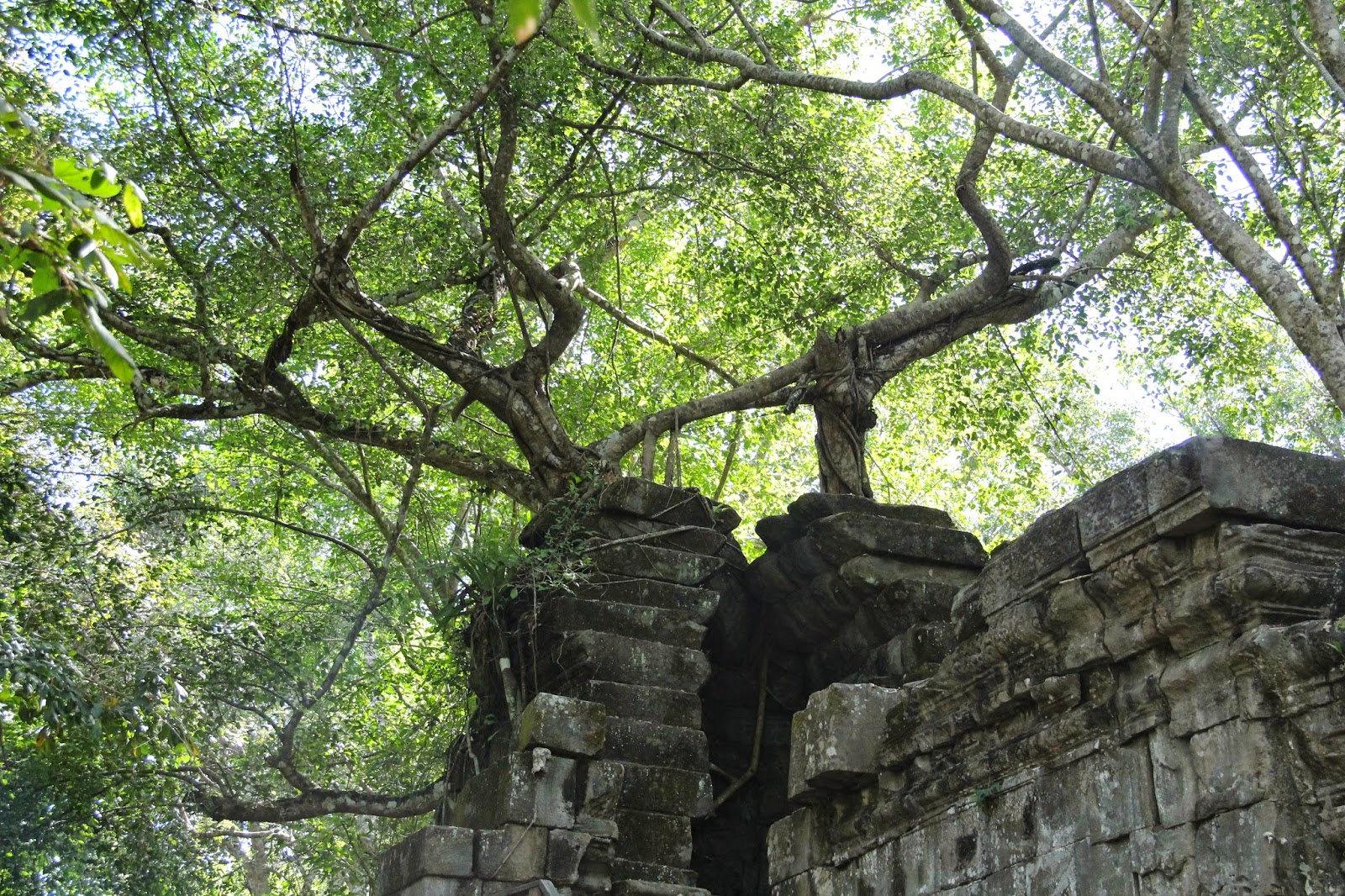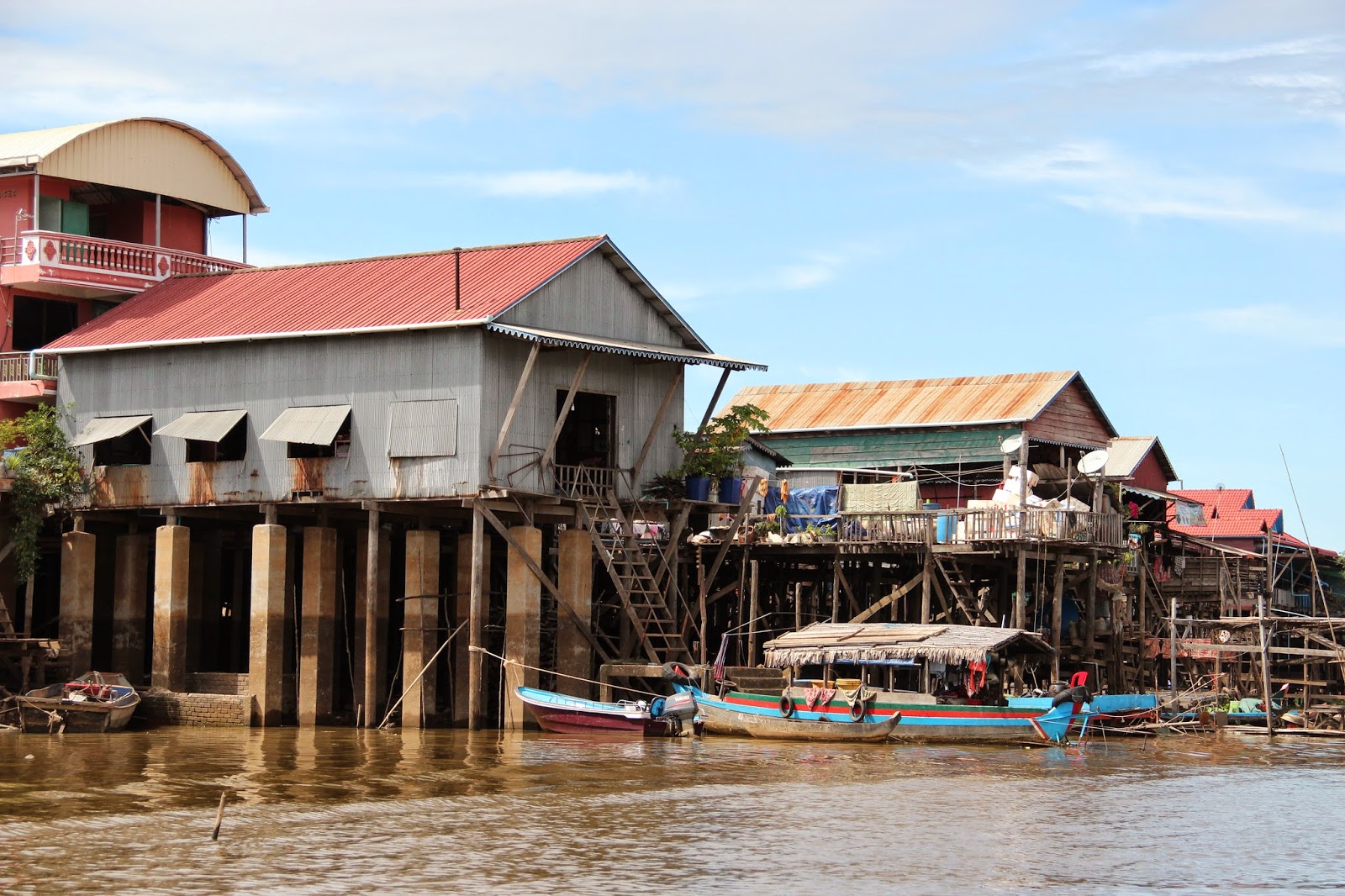After breakfast, we head into the countryside for a while. We are going to Beng Melea temple, about 50 miles away and have our same driver and guide. We could do this on our own, but Bob has been very helpful and informative and this is one economy we don't mind supporting! The temples have entry fees which help with maintenance and personnel.
We pass quite a few rice fields and they are harvesting by hand in several. Some areas can get 2-3 harvests a year while others get only one. We also see several water buffalo including some pulling carts.
Even here many of the houses are on stilts and use bamboo and thatching or simple boards. There are occasional "shops" which sell rice, fruit and gasoline. The gas is sold in used bottles - like Johnny Walker or Pepsi - and is mainly for the scooters, motorbikes and boats.
The land is flat, though we can see some mountains in the distance. That is where all the stone used to build the temples came from.
Cambodia has a king, but he is a figurehead only, with no power per Bob. He does not appear to be revered as the King of Thailand is. They are now considered a democracy, although Chap says it is very corrupt and more like a dictatorship. In the country some people drive a vehicle like this, which also operates as a plow/planter for the rice.
 |
| Schoolgirls along the road. |
We pass a group of small yellow houses which, Bob informs us, are government-provided housing for land mine victims. Some of these areas have no electricity and use cisterns for water. Bob said his home village only got electricity 2 years ago, but they did have generators.
Beng Melea temple has not been restored at all and one of its claims to fame is that it was featured in the Indiana Jones, Temple of Doom movie. It has a moat which is overgrown. A 7 headed naga leads the way to the temple. Seven heads has something to do with the colors of the rainbow.
This temple was built as a rural place of worship and education, about the same time as Angkor Wat. The style and engravings are similar. Many of the fallen rocks here have holes in them which were used during their transport. The jungle is slowly reclaiming the area, as you can see from the multitude of trees and winding roots.
We leave here and in about half an hour we reach Tonle Sap Lake. We stop briefly at a small village along a dirt road which will be under water at the height of the rainy season.
We are a month into the dry season now and the water level is low, but will go much lower before the monsoons arrive again in March or so. The depth at the center will vary from 3 meters at the height of dry season, to 15 meters during the rainy season. There are about 2,000 families living in this area. Most are fishermen. We see men staking out nets, drying fish and motoring about. Many types and sizes of boats most of which are wooden. Some are rather primitive, almost like dug-out canoes.
The Mekong River feeds this lake and there are some Vietnamese who escaped Vietnam during our war/fiasco and settled here. The Tonle Sap river flows from the Mekong to the Lake during rainy season and from the lake to the river during dry season!
We board a boat and cruise through the village which is all on the water. The boat is pretty rickety and the driver and his helper are very young but proficient. After a while we reach another kind of village, they call the floating village. Folks here live on their boats and can move as the water level changes.
 |
| Floating house |
 |
 |
| Our driver. Many people wear protection from the sun. |
 |
| Floating school |
On the return to Siem Reap we pass many stands selling sticky rice in bamboo. It is a glutinous rice mixed with some coconut milk and a few black beans and steamed in the bamboo. We stop to take a photo and I buy one which we share. Tastes good.
Our new phrase for getting out of the car: "Let's Eject," which Bob says everytime we stop. That and "Let's Roll" seem to be favorites of his!
We stop at Stueng Trorcheak Restaurant and Garden for a late lunch, then head back to town. We agree to meet later for dinner.
Tonight we go to a Japanese/Khmer place near the Old Market, called Hot Stone, which had good reviews. Very disorganized, they were out of "finished" many items, service took forever, food was mediocre and they couldn't even get the bill right. Definitely an off day. All we can figure is that you need to get there early for the good stuff.
Back to the hotel. There are 18 different language TV stations! US visitors make up only a small portion but there are 5 or 6 English TV channels. There is a marathon tomorrow at Angkor Wat and they expect several thousand runners, which must be good for their economy!
























No comments:
Post a Comment